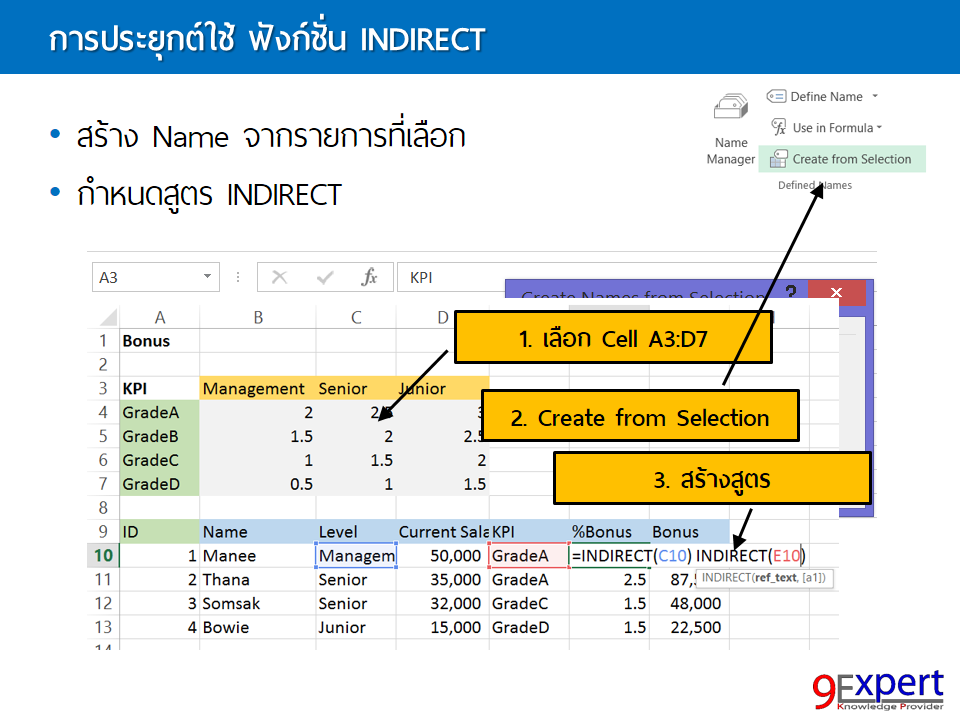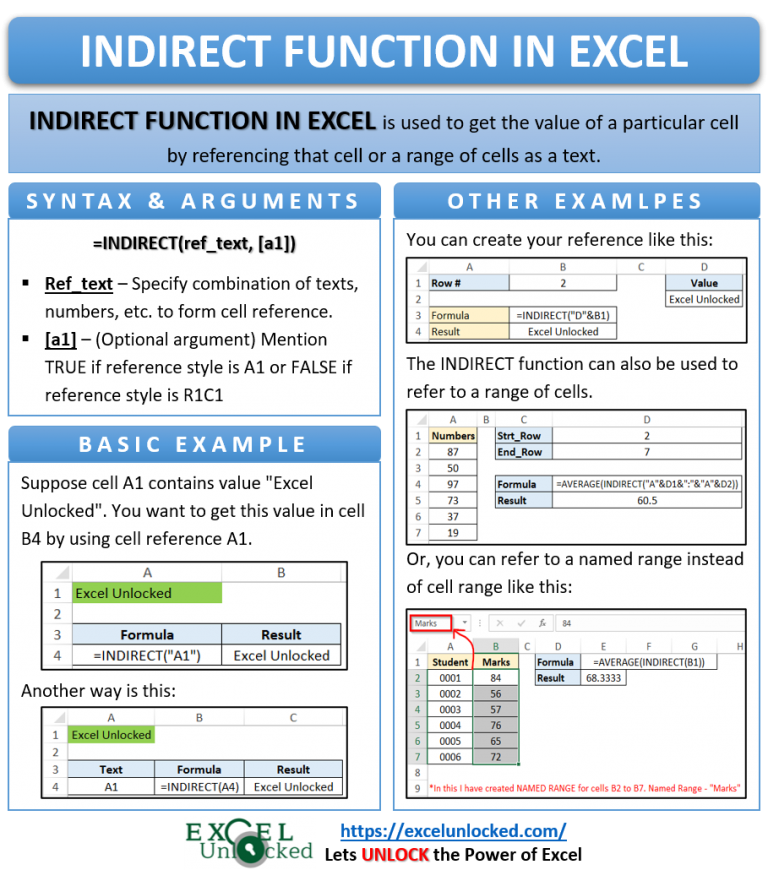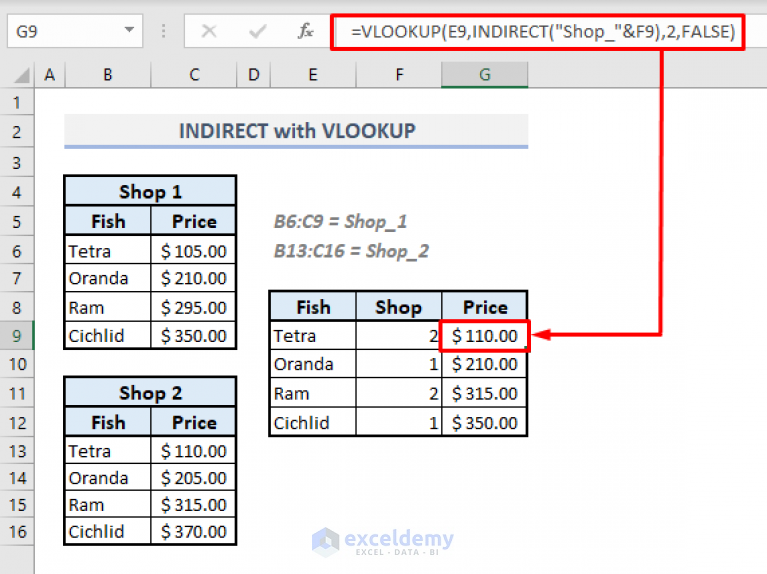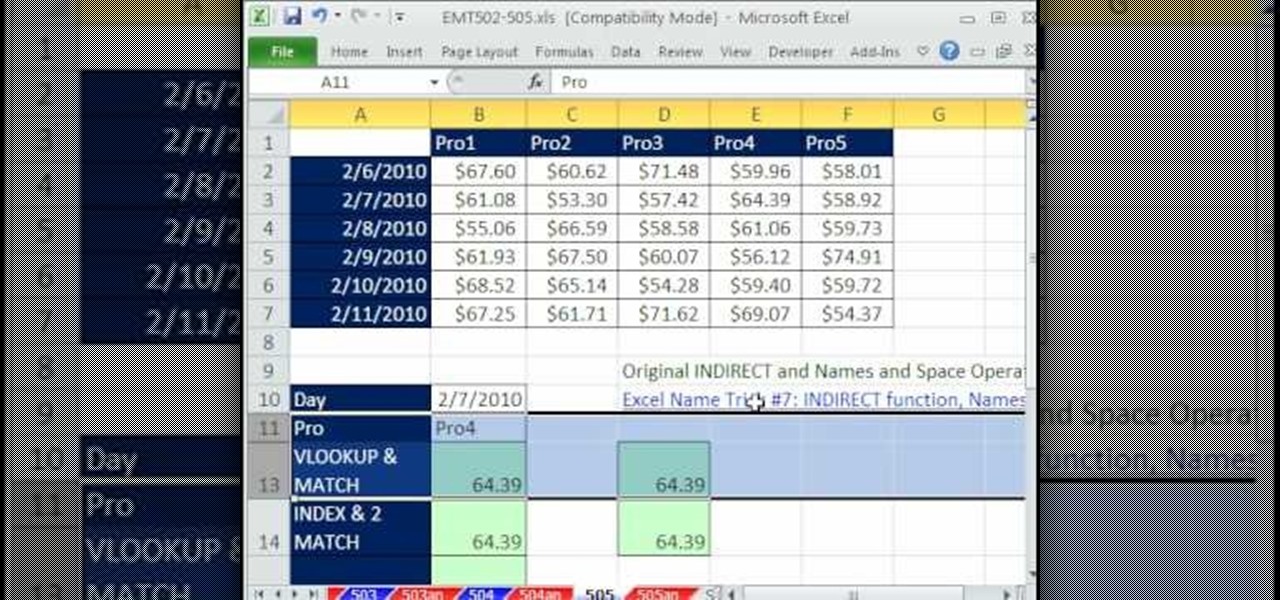
Best Indirect Formula Excel most complete Formulas
12 Answers Sorted by: 14 There is definitively no way to do this with standard formulas. However, a crazy sort of answer can be found here. It still avoids VBA, and it will allow you to get your result dynamically. First, make the formula that will generate your formula, but don't add the = at the beginning!

How to use the Excel INDIRECT function ExcelFind
Excel INDIRECT Function The INDIRECT function returns references according to the text value. It takes the value as a string (ref_text) and returns the references with that name. These references can be cells, named ranges, or worksheets. Syntax =INDIRECT (ref_text, [a1])

Excel INDIRECT Function Help Examples
Example #1 - Variable worksheet name In the example shown above, INDIRECT is set up to use a variable sheet name like this: = INDIRECT (B5 & "!A1") // sheet name in B5 is variable The formula in B5, copied down, concatenates the text in B5 to the string "!A1" and returns the result to INDIRECT.
/excel-indirect-function-580bb7145f9b58564cf69f6f.jpg)
Learning the Excel INDIRECT Function
Within tblVal, you cannot just refer directly to Europe, for example, to get the list of entries from J7:J15. You can return that range however, if you use Indirect, by typing =INDIRECT ("tblval [Europe]") Alternatively, you need to create a named range with Name Manager of Europe with Refers to: =tblval [Europe]

Excel INDIRECT Function Using INDIRECT Function in Excel YouTube
What Is the Indirect Function? The indirect function is a way to convert a text string into a reference. That is, it draws information from a reference to another cell or range. It creates a reference from text, and doesn't change when cells, rows, or columns are altered, added, or removed from a cited range.

50 Keyboard Shortcuts for MS Excel in 2021 Excel for beginners, Office administration, Ms office
= INDIRECT (B5) Where the worksheet contains the following named ranges: category = E4:G4

EXCEL INDIRECT FUNCTION YouTube
Description The Microsoft Excel INDIRECT function returns the reference to a cell based on its string representation. The INDIRECT function is a built-in function in Excel that is categorized as a Lookup/Reference Function. It can be used as a worksheet function (WS) in Excel.

INDIRECT Function In Excel ExcelHelp
Syntax INDIRECT (ref_text, [a1]) The INDIRECT function syntax has the following arguments: Ref_text Required. A reference to a cell that contains an A1-style reference, an R1C1-style reference, a name defined as a reference, or a reference to a cell as a text string. If ref_text is not a valid cell reference, INDIRECT returns the #REF! error value.

The Indirect Function Excel 2016 Level 3 YouTube
Lookup and reference. Description: Returns a reference indicated by a text value. Return Value: A valid worksheet reference. Syntax: =INDIRECT (ref_text, [a1]) Applies to: Excel 2016, Excel 2013, Excel 2011 for Mac, Excel 2010, Excel 2007, Excel 2003, Excel XP, Excel 2000.

INDIRECT Function in Excel Get Values from Reference Excel Unlocked
What is the INDIRECT function in Excel? What is the INDIRECT formula used for? Let's Wrap Up Objective Use the Excel INDIRECT function to indirectly reference cells and ranges. The Excel INDIRECT Function — Explained The INDIRECT function is part of the Lookup and Reference group of functions in Excel.

Excel Reference Sheet Name Indirect
The INDIRECT function in Excel returns a cell reference from a text string. It has two arguments, the first is required and the second is optional: INDIRECT (ref_text, [a1]) ref_text - is a cell reference, or a reference to a cell in the form of a text string, or a named range.

Excel INDIRECT Function Example + Sample File
The INDIRECT function is really cool as it opens up a lot of interesting combinations in Excel. We will use the power of the INDIRECT function right now on creating a Conditional Drop Down list Excel. Watch the data validation indirect in Excel on YouTube and give it a thumbs-up!

Excel Indirect to update range YouTube
1. For example, take a look at the INDIRECT function below. Explanation: =INDIRECT (A1) reduces to =INDIRECT ("D1"). The INDIRECT function converts the text string "D1" into a valid cell reference. In other words, =INDIRECT ("D1") reduces to =D1. 2. The simple INDIRECT function below produces the exact same result. 3.

How to Use INDIRECT Function in Excel (12 Suitable Instances)
INDIRECT. At this point, all that remains is to write the formula. We need to create the desired reference with a text string and then pass it to the INDIRECT function. The INDIRECT function will convert the text string into a valid Excel reference. For example, let's say that we ultimately wanted to sum up the Q1 column of the DeptA table.

How to Use INDIRECT, TEXT, and SUBSTITUTE in Excel « Microsoft Office WonderHowTo
Syntax INDIRECT (ref_text, [a1]) The INDIRECT function syntax has the following arguments: Ref_text Required. A reference to a cell that contains an A1-style reference, an R1C1-style reference, a name defined as a reference, or a reference to a cell as a text string. If ref_text is not a valid cell reference, INDIRECT returns the #REF! error value.

Excel function INDIRECT how to use the excel indirect formula Doctor Excel YouTube
1 I have a formula containing INDIRECT () pointing to some range -- call it B4:F8. If I specify the range explicitly, like this: =INDIRECT ("B4:F8") then it works fine. However, if the range in question is actually a dynamic array, of unknown size but anchored at B4, and I use the # spill operator to specify it, like this: =INDIRECT ("B4#")